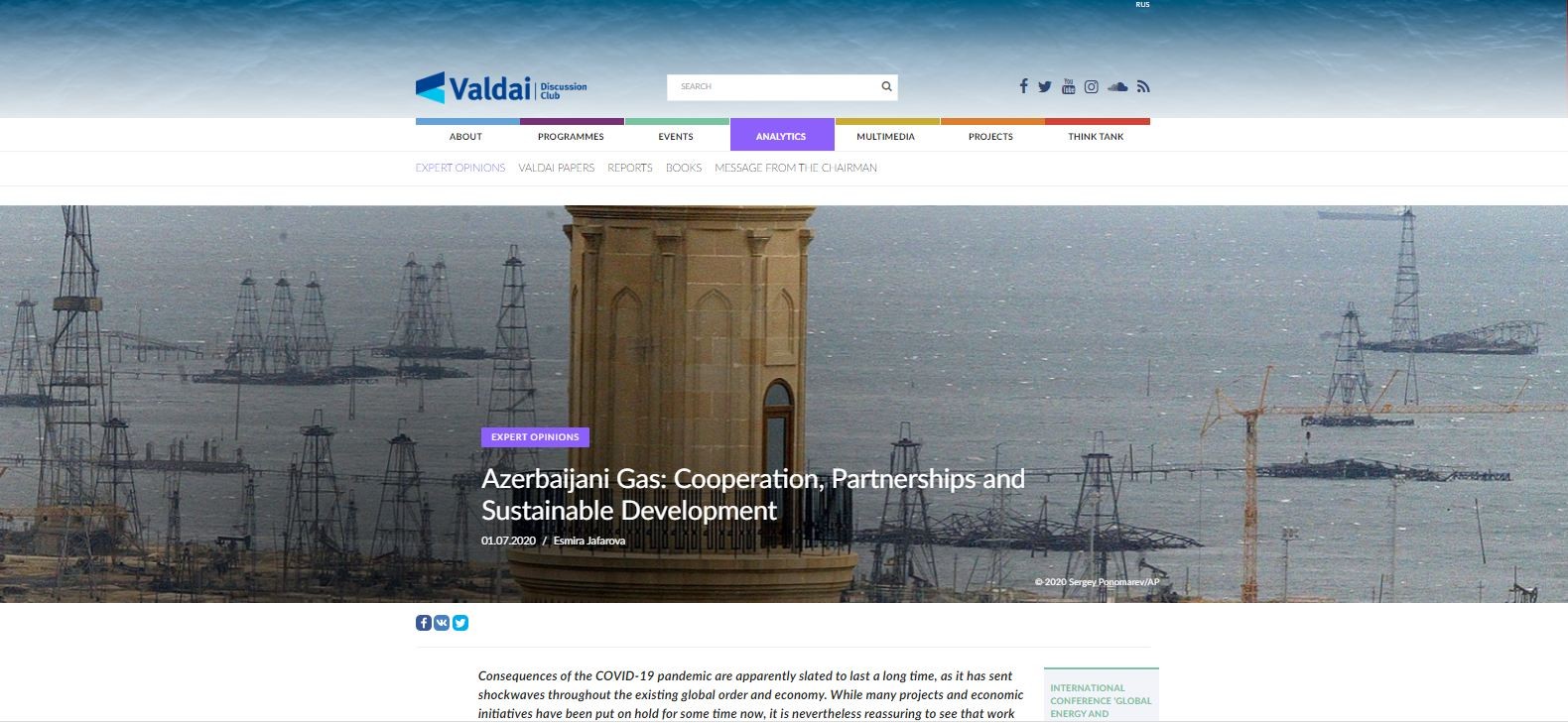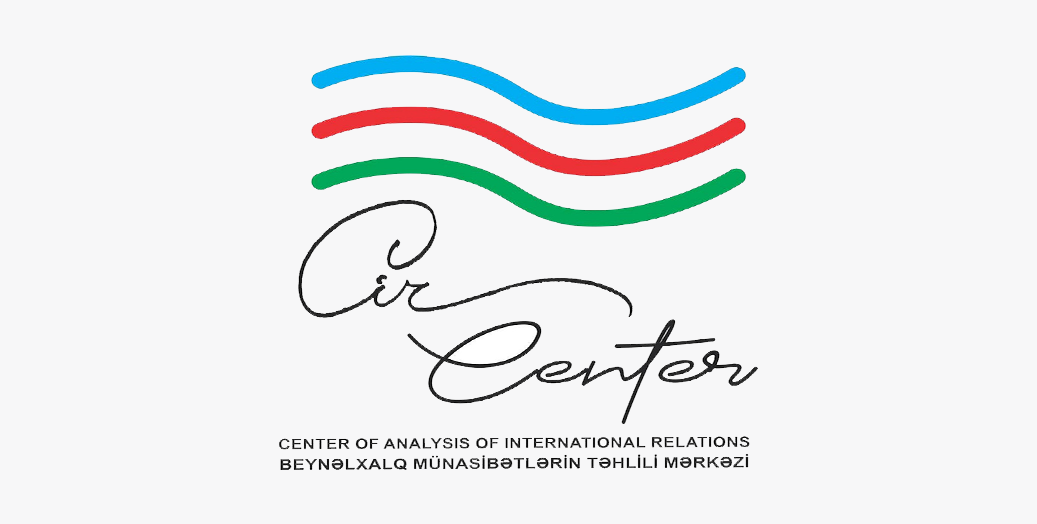Consequences of the COVID-19 pandemic are apparently slated to last a long time, as it has sent shockwaves throughout the existing global order and economy. While many projects and economic initiatives have been put on hold for some time now, it is nevertheless reassuring to see that work on the Southern Gas Corridor is approaching final completion, writes Esmira Jafarova, Board Member of the Baku-based Center of Analysis of International Relations (AIR Center), who participates in the international conference “Global Energy and International Political Risks”, to be held by the Valdai Club and AIR Center on July 2-3.
Azerbaijan started its journey as an energy exporting country after signing the “Contract of Century” in 1994, together with its international partners, to embark on the exploitation of the hydrocarbon resources of the Caspian Sea. The ensuing developments were the natural outcome of the thoughtful energy strategy initiated by the nation’s leader, the late President Heydar Aliyev. The Baku-Tbilisi-Ceyhan oil pipeline (2005) and Baku-Tbilisi-Erzurum gas pipeline (2006) further enhanced Azerbaijan’s role as an energy producer and exporter country, whose name is also associated with large-scale regional energy infrastructure projects. Azerbaijan boasts 2.6 trillion cubic meters of gas reserves, and when the existing Baku-Tbilisi-Erzurum gas pipeline did not suffice for the transportation of Azerbaijan’s gas reserves, the idea of the Southern Gas Corridor gained momentum in 2013. In that year another important development for the Southern Gas Corridor became the finalisation of the debate over the final itinerary of the project, when Azerbaijan selected the Trans-Adriatic Pipeline (TAP) over the competing Nabucco-West project for the transportation of Caspian gas to Europe.
The 3,500 km-long Corridor consists of four segments: the “Shah Deniz-II” project, the Southern Caucasus Pipeline Extension (SCPX), the Trans-Anatolian Pipeline (TANAP) and its final portion, the Trans-Adriatic Pipeline (TAP). The Corridor passes through seven countries – Azerbaijan, Georgia, Turkey, Bulgaria, Greece, Albania and Italy, with Italy being the final destination to receive Caspian gas. The official inauguration ceremony of the Southern Gas Corridor happened on May 29, 2018 in Baku and Phase 0 of TANAP began on June 12, 2018 in Eskişehir, Turkey. Later, Phase 1 of TANAP was inaugurated 30 November, 2019 in İpsala, Turkey. Turkey is already receiving gas via TANAP and as of June 2020 is expected to receive 6 billion cubic meters of gas. Europe is set to receive 10 billion cubic meters of Azerbaijani gas per year and it has already started to arrive in Albania. The Southern Gas Corridor is scheduled to be fully operational by fall 2020 and TAP is almost complete with a completion rate of over 96%, despite previously facing some problems in Italy’s south over environmental concerns, which later were eliminated with the Italian government finally approving TAP in late 2018. It seems that ever since, things have been in full swing, and even the challenges presented by COVID-19 haven’t been able to halt the success of the Southern Gas Corridor.
With the COVID-19 pandemic hitting the world and bringing many uncertainties amid the global lockdowns, global economic activity has naturally slowed down. The consequences of the pandemic are apparently slated to last a long time, as it has sent shockwaves throughout the existing global order and economy. While many projects and economic initiatives have been put on hold for some time now, it is nevertheless reassuring to see that work on the Southern Gas Corridor is approaching final completion. At the initial stage, the Southern Gas Corridor is set to deliver about 16 billion cubic meters of gas: 6 bln m3 to Turkey and 10 bln m3 to Europe. However, the project also has the potential for an expansion in capacity, which can be increased to 31 billion cubic meters in SCPX and TANAP, and up to 20 billion cubic meters for TAP – thus doubling the latter’s capacity. This also means that Azerbaijan possesses further gas reserves in its portion of Caspian Sea, in its Absheron, Umid and Babek fields, as well as Karabakh, Dan Ulduzu and Ashrafi – that might in the future provide additional volumes for the infrastructure and increase gas exports to many corners of Europe. The final stage of the implementation of the Southern Gas Corridor is already happening and the successful completion of TAP and the Corridor overall seems to be just around the corner, with the first gas being pumped into the Albanian section of the pipeline. With the finalisation of works on TAP and completion of the Southern Gas Corridor, as planned, in late 2020, Azerbaijan will contribute to the energy security of Italy as well as the countries of South Eastern Europe. Through the Southern Gas Corridor, Azerbaijan will ensure the diversification of routes and sources for the natural gas while contributing to the de-carbonisation efforts of the broader continent. TAP also stands out as an important link within the Southern Gas Corridor, and through its linkages to other interconnectors in Europe, such as Interconnector Greece Bulgaria (IGB), the Ionian Adriatic Pipeline (IAP), and the Bulgaria-Romania-Hungary-Austria gas pipeline (BRUA project) can open up new perspectives for other countries to benefit from new supply sources.
Recently we witnessed another momentous achievement in the introduction of the Southern Gas Corridor, as the first gas was pumped into the several-kilometre-section of TAP in Albania, on the Greek-Albanian border. Further plans include gradually introducing gas into other parts of the Albanian portion of TAP. This milestone was also important because it came amid the COVID-19 pandemic, which might have potentially created headwinds on the road to progress. This however, did not happen and as the situation stands for today, works towards the timely completion of the Southern Gas Corridor seem to be proceeding at full throttle to the greater benefit of Azerbaijan, its immediate neighbourhood and ultimately to Europe’s energy security. This also once again attests to the importance attached to the Southern Gas Corridor by its international partners.
Besides its immediate strategic objective, the Southern Gas Corridor is also a huge infrastructure project –a multimillion euro megaproject – and hence its name, “The Corridor”. The implementation of the Corridor became possible only through consistent and targeted international cooperation, partnerships, political will and unity of purpose. That also means that other countries wishing to use this infrastructure that is already in place could potentially benefit from the partnership. This kind of partnership and cooperation eliminates a sense of competition for the greater benefit of countries and their people. It once again testifies to the fact that the Southern Gas Corridor carries great potential to contribute significantly to Europe’s energy security and sustainable development.
https://valdaiclub.com/a/highlights/azerbaijani-gas-cooperation-partnerships/







